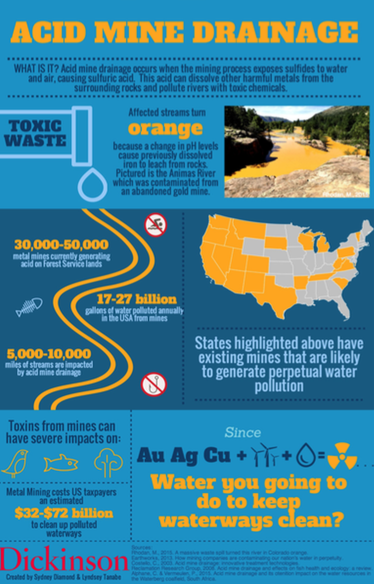Students to Conduct Research with Ruffalo’s Team
Scott Smith, chief scientist of Mark Ruffalo’s non-profit organization Water Defense, invited two Dickinson students to perform field research on acid mine drainage in Navajo Nation, a semi-autonomous Native American-governed territory in Arizona, Utah and Nevada.
Sydney Diamond ’16 and Lyndsey Tanabe ’16 presented an info graphic about acid mine drainage for their Analysis and Management of the Aquatic Environment class, taught by Kristen Strock, assistant professor of Environmental Studies. All students in the class were required to design an info graphic about an aquatics disturbance issue and displayed their work in an in-class poster presentation on Oct. 6.
Ruffalo was visiting the class that day as part of his residency for the Rose-Walters Prize for Environmental Activism.
Smith was impressed by Diamond and Tanabe’s visualization of a little- known environmental issue and invited both students to perform research in Navajo Nation, where water sources such the Animas River have been contaminated by the run-off of sulfuric acid and heavy metals from industrial mining sites. Tanabe said that Smith will also publish their info graphic on the Water Defense website and social media channels.
Diamond said that the students learned two weeks in advance that Ruffalo and representatives from Water Defense would visit class to view their work. She and Tanabe, who both work for ALLARM and studied aquatics issues abroad, decided to research an aquatics issue that the organization had already researched and publicized. They both learned about acid mine drainage for the first time from the Water Defense website.
“We had heard nothing about acid mine drainage [before viewing the website],” Diamond said. “We had no idea it was a such a big issue, so we decided to do our project on that.”
Diamond and Tanabe worked on the info graphic for two weeks, designing it to match the Water Defense color scheme and aesthetics. According to Diamond, they wanted the final product to be able to be compatible with the Water Defense website.
Diamond said that Smith was the first member of Ruffalo’s team to see their infographic.
“We saw [Smith] first and he was totally pleased with the info graphic and wanted to show [Ruffalo],” Diamond said. “[Ruffalo] was super receptive to what we had done and suggested that we use it as a link between Dickinson and Water Defense. The next thing we know is [Smith] is saying, ‘we have to get you on the ground in Navajo Nation to collect samples.’”
According to Tanabe, their trip to Navajo Nation will allow them to meet with the indigenous populations who are the most affected by the drainage.
“We hopefully will test the water quality in the Animas River and see how it has changed over time since [Water Defense first began researching there,]” Tanabe said. “That data will be shared with the [indigenous] people who live in that area.”
Tanabe and Diamond both stressed the importance of publicizing acid mine drainage to the public.
“It’s definitely a ‘now’ issue and the big problem is that the public doesn’t know about it,” Diamond said. “[Water Defense] wants to get us out there, get data and get information out [to the public].”
Diamond and Tanabe said they are in contact with Smith and hope to “get the ball rolling” and plan the trip within the next two weeks. In the meantime, both students are enjoying the gratification of the Water Defense team’s recognition of their work.
“I was totally on cloud nine today,” Diamond said. “It’s super satisfying to know that you worked hard for a cause that you care about and to see that other people [respond] in a really positive, action-empowered way.”




